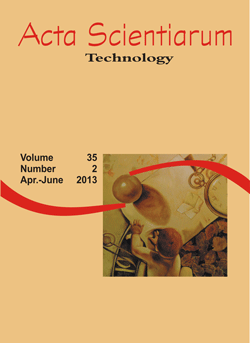<b>Application of activated sludge process followed by physical-chemical processes in the treatment of industrial saline effluent for reuse</b> - doi: 10.4025/actascitechnol.v35i2.13006
DOI:
https://doi.org/10.4025/actascitechnol.v35i2.13006Palavras-chave:
water reuse, saline effluent, activated sludge, coagulation/flocculationResumo
The treatment of complex effluent with high salinity and sometimes with toxicity rates from a chemical plant is investigated. Two reactors were monitored continuously: control reactor R1 and reactor R2 adapted for saline effluent with 25h-HRT. The adaptation process to saline effluent (0 - 100%) was effective in removing COD and N-NH4+, respectively with 70 and 85% efficiency. After adaptation, the sequence coagulation/flocculation (40 mg L-1 PAC coagulant and 0.3 mg L-1 cationic polymer), rapid downflow sand filter (120 m3 m-2 day) and reverse osmosis to obtain water for reuse was analyzed. Results obtained by coagulation/flocculation and sand filter sequence were satisfactory, mainly with the removal rates of turbidity at 50-65 and 98%, respectively. Average removals of 91, 87, 98 and 98% were obtained for COD, N-NH4+, TOC and Cl-, respectively, in reverse osmosis, with all parameters below the limits for reuse in cooling towers. However, membrane fouling was detected.Â
Downloads
Downloads
Publicado
Como Citar
Edição
Seção
Licença
DECLARAÇíO DE ORIGINALIDADE E DIREITOS AUTORAIS
Declaro que o presente artigo é original, não tendo sido submetido í publicação em qualquer outro periódico nacional ou internacional, quer seja em parte ou em sua totalidade.
Os direitos autorais pertencem exclusivamente aos autores. Os direitos de licenciamento utilizados pelo periódico é a licença Creative Commons Attribution 4.0 (CC BY 4.0): são permitidos o compartilhamento (cópia e distribuição do material em qualqer meio ou formato) e adaptação (remix, transformação e criação de material a partir do conteúdo assim licenciado para quaisquer fins, inclusive comerciais.
Recomenda-se a leitura desse link para maiores informações sobre o tema: fornecimento de créditos e referências de forma correta, entre outros detalhes cruciais para uso adequado do material licenciado.



















